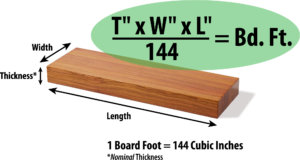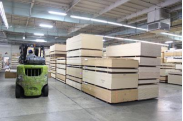-actual customer quote (except he didn’t say @#$%)
WELL, HE’S GOT A POINT. WE ASSUME EVERYBODY KNOWS WHAT A BOARD FOOT IS. OUR BAD, SORRY! The answer:

Okay, okay, more: most people think Board Foot sounds simple and don’t think they need it explained. (Oh sure, it’s all fun until somebody gets hurt).
So, let’s see if we can help you out. Pay attention, ’cause it gets a little goofy.
A Board Foot is a Measure of Volume
Not length (linear foot), not area (square foot). VOLUME. And that volume is the equivalent of a board that is 1 inch thick by 12” wide by 12” long. (For you math majors, that’s 144 cubic inches. Now go back to your gaming, we’re building stuff here).
All of these boards measure One Board Foot (with the formula):
1” thick x 12” W x 12” L (1x12x12)/144=1
1” thick x 6” W x 24” L (1x6x24)/144=1
1” thick x 3” W x 48” L (1x3x48)/144=1
Got it? Let’s have some fun:
These boards are also 1 Board Foot:
2” thick x 12” W x 6” L (2x12x6)/144=1
2” thick x 6” W x 12” L (2x6x12)/144=1
4” thick x 4” W x 9” L (4x4x9)/144=1
OK, HERE’S THE REAL FORMULA, AND OUR FIRST TWIST:
(Nominal Thickness x Width in Inches x Length in Inches) divided by 144
-OR- (Nominal Thickness x Width in Inches x Length in FEET) divided by 12
You: What’s this Nominal B.S.?
“Whoa whoa whoa whoa. You tryna trick us??” Okay, here’s the deal: nominal means “in name only” or “what we call it”. The best example comes from softwoods. You know that thing we call a “Two-by-Four”, and it’s not two inches by four inches, it’s only 1-1/2×3-1/2? Well “2×4” is the nominal measure. We call it a 2×4, but the actual measure is less.
It’s the same in hardwood lumber. Hardwood lumber thicknesses are 4/4, 5/4, 6/4, 8/4, 12/4, etc. Those are “nominal” thicknesses. When the sawmill sliced up the log, they cut some to a true 1” thickness (4/4). Or 1-1/2” (6/4). Or 3” (12/4). But then they surfaced it and it got thinner. Then it was surfaced again and it got even thinner. And when you buy it, that “4/4” lumber is only 13/16”, or maybe 3/4” (*see below). Guess what, it’s still measured as 4/4. When calculating Board Feet, 4/4 = 1, and 5/4 = 1.25, and 6/4 = 1.5, and 8/4 =2.
So, you measure a board with a tape measure (not how we do it, but more on that later), and it’s 13/16” thick and 6” wide and 8 feet long. Calculate the Board Feet this way:
1 x 6 x 96 = 576. 576 / 144 = 4 BF
-OR- 1 x 6 x 8 = 48. 48/12 = 4 BF
Yes, we know, the board isn’t 1” thick. But it’s nominal measure is 1”. (It used to be 1”, and it’ll always be a value of 1 for measurement purposes, no matter how thin you plane it down).
“How do I know how thick it is?” ASK US. Here at Valencia Lumber and Panel, we have signs and labels in the racks to indicate the nominal thickness. You might find maple lumber “in the rough” (blanked, not surfaced yet) that measures 15/16”. The sign will say “4/4”. Next to it, there’s maple lumber that measures 13/16”. The sign will say “4/4”. Then you might find some maple lumber that measures 1-13/16” thick. Wanna guess? If you said 8/4, you’re right. Those boards started at 2” at the mill and were planed down to a nice smooth surface to 1-13/16”. And if you were tallying those, you’d do this:
2 x width” x length”, and then divide by 144
Did You Say Tally?
Why, yes! Yes I did say tally. Thanks for asking. We don’t measure hardwood lumber with a tape measure. We follow the rules established by the National Hardwood Lumber Association (NHLA) and we use a “tally stick”, which is used in every mill all over the place. A tally stick is elegant in its simplicity, and a very efficient method for measuring/counting hardwood lumber. (Tally sticks date back to King Henry 1st, in 1100 AD, and yes, the term “short end of the stick” comes from tally sticks. Look it up, interesting stuff. Now you can say you learned history today, too). Ask any of our staff if you’re curious, and they’ll be happy to show you how a tally stick works.
Which brings us to the other little twist: measuring the width of the board. With a tally stick, you measure a board in three places and take the average of those to determine width. Once you’ve used a tally stick for a while, you simply eyeball the board to find the place which is the average width and that’s where you take your tally. Pros, like the people working the grading line in a sawmill, or our staff, are really fast with a tally stick.
So, now you know everything you ever wanted about Board Feet. Now go build something beautiful.
One last thing…
*A word about thickness of surfaced lumber. Home centers surface their hardwood lumber to 3/4” (12/16”). That’s fine for the hobbyist, do-it-yourselfer, most of us. Valencia Lumber and Panel provides the professional woodworker thicker stock at 13/16”. That gives them more leeway to surface it further, sand it, etc. depending on their needs. That additional 1/16” is very important to the pro. Pretty funny story about that topic HERE
By the way, we do provide some lumber that is 3/4″ thick: our 1×6, 1×8 and 1×12 Poplar is surfaced on four sides (S4S), and it is planed to 3/4″. Visit our lumber shop in Van Nuys.



